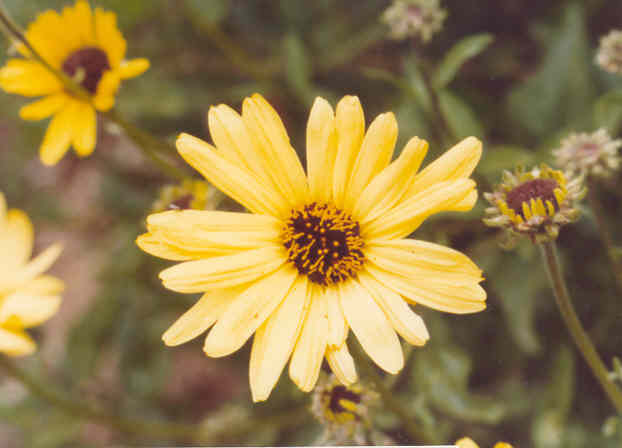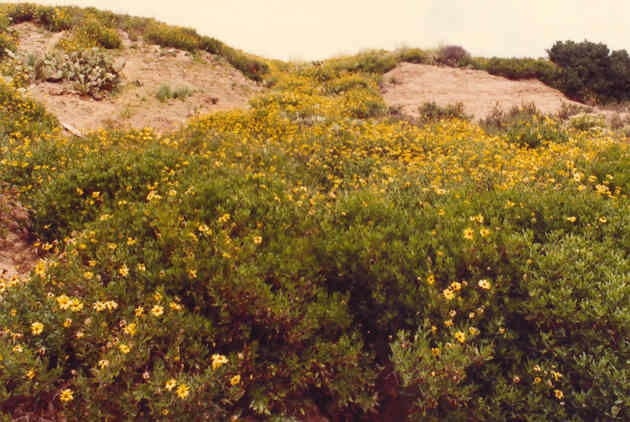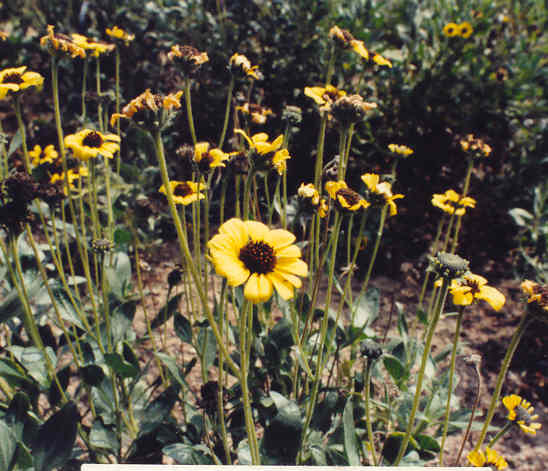
Encelia Californica Nutt.
 |
Encelia Californica Nutt.
Asteraceae (Sunflower Family)NativeCalifornia EnceliaBush SunflowerEncelia Daisy |
April Photo
Plant Characteristics: Rounded shrub, 6-12 dm. high and often broader, much branched; stems and peduncles canescent; lvs. 3-6 cm. green, appressed-pubescent, ovate to lanceolate, entire, or repand-dentate, petioles 5-25 mm.; heads radiate, solitary; invol. 10-12 mm. high, tomentose; phyllaries lanceolate; rays 1.5-3 cm. long, yellow, neutral; disk fls. flat, obovate, villous-ciliate, +/- pubescent; corollas purplish; aks. 5-6 mm. high; pappus 0 or of 2 slender awns.
Habitat: Coastal bluffs and open or bushy slopes below 2000 ft.; Coastal Sage Scrub, Chaparral; Santa Barbara co. to L. Calif., inland to w. Riverside and w. San Bernardino cos., Santa Catalina, San Clemente, Santa Cruz Ids. Feb-June.
Name: Named for Christoph Entzelt, an early Lutheran clergyman, who Latinized his name to Encelius and wrote a book in 1551 about the medicinal uses of minerals, animal parts and plants. His book is quoted as a source of plant names. (Dale 61). Californica indicates that the plant was first found in this state. (Dale 13).
General:
Very common in the study area. (my
comment). This plant has a strong odor
and is rough to the touch, but it is very colorful and attractive.
(Dale 61).
Drought-deciduous communities called coastal sage scrub are closely
associated with chaparral areas from central California to northwestern Baja
California. In contrast to
evergreen chaparral shrubs, the dominant species of coastal sage scrub are lower
(one and one-half to five feet tall), less woody, and have soft mesophytic
(requiring medium conditions of moisture and dryness, intermediate between a
hydrophyte and a xerophyte) leaves that are largely lost during the periods of
summer drought. These
characteristics have led to the local name “soft” chaparral.
The characteristic species are California sagebrush (Artemisia californica), several species of sage (Salvia),
Encelia californica and California buckwheat (Eriogonum fasciculatum). Such
evergreen shrubs as lemonadeberry (Rhus integrifolia), laurel sumac and toyon may also be common.
Coastal sage scrub communities occur extensively along lower coastal
areas, generally below the elevation belt where evergreen chaparral shrubs
predominate. It is generally
believed that the length of the summer-drought period in these coastal habitats
precludes the success of most evergreen shrubs.
It is not surprising, therefore, to find coastal sage scrub in a narrow
zone between chaparral and desert arid grasslands on the inner side of the Coast
Ranges. Coastal sage scrub species
do occur in the higher-elevation chaparral belt, as post-disturbance colonizers
or on steep or rocky xeric sites. (Rundel,
Philip W.
“Structure and Function in California Chaparral”. FREMONTIA, A Journal of the California Native Plant
Society. October 1986. pp.
3-10. In
March 1994 I observed a ground squirrel eating the petals from the flowers of E.
californica. The squirrel had
climbed into the plant and would reach out for a pedicel to pull the flower in
close, it would then devour the petals in what I estimate to be less than 10
seconds, then reach for another flower. (my
comments). Delfina
Cuero, a Kumeyaay or Southern Diegueno Indian made the following
comment about Encelia californica in her autobiography:
“The Indian
name Nahekwi means ‘it watches the sun’; I did not use it.” (Shipek
89).
Long before bees
evolved (perhaps in the Oligocene, 22.5 to 38 million years ago) to become the
most significant flower visitors, beetles were consuming pollen of primitive
flowers. Nectar offerings evolved
later. Like so many antecedent
steps in evolution, the relationship between primitive flowers and their crude
“mess and spoil” visitors gobbling pollen shed in floral receptacles
continues to this day. Beetles are
found in many modern day flowers and most are specialists.
Those of the family Dasytinidae, especially its genus Listrus,
spend their entire adult lives in flowers.
As many as fifty individuals swarm in a single disk, some burrowing
straight down into florets, undoubtedly supplementing their pollen diet with
nectar. Some beetles, such as the
common ladybird beetles, Hippodamia
convergens, not only eat small insects, especially aphids, but also readily
partake of nectar and pollen while incidentally functioning as pollinators.
(Ross, Edward S. “Insect/Plant Relationships: A Photographic Essay”
FREMONTIA, A Journal of the California Native Plant Society.
April 1996 pp. 2-22).
About 14 species from sw U.S. to Mex., Peru, Chile, Galapagos Ids.
(Munz, Flora So. Calif. 157).
Text Ref: Hickman, Ed. 249; Munz Flora So. Calif. 158.
Photo Ref: April 6 83 #10,11,E.
Identity: by R. De Ruff.
First Found: April 1983.
Computer Ref: Plant Data 166.
No plant specimen.
Last edit 7/30/05.
 |
 |
April Photo October Photo